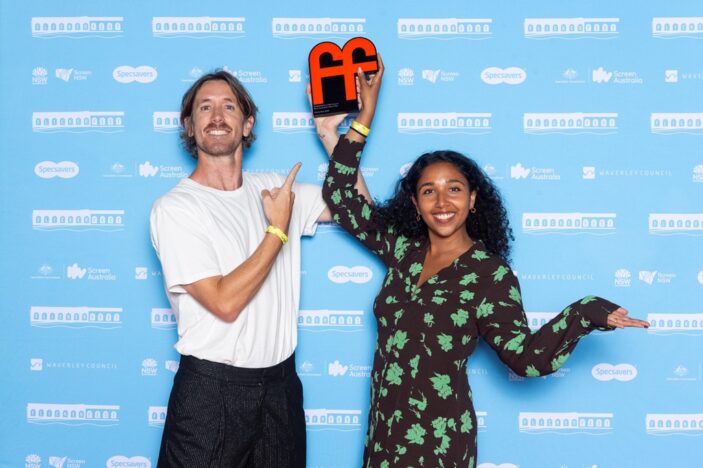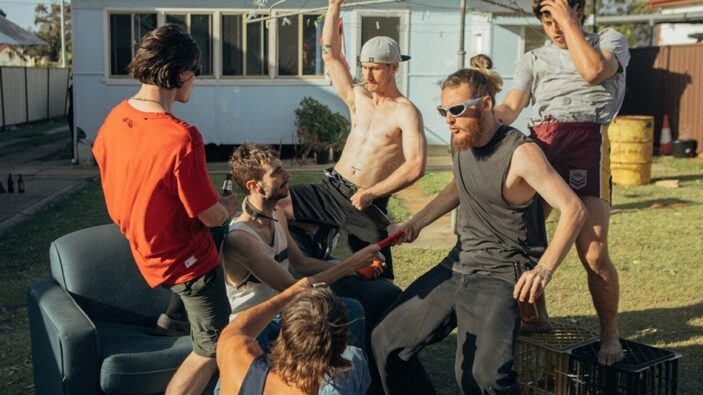
Created by the Sydney’s husband-and-wife director-choreographer duo Stefan Hunt and Vanessa Marian, Yeah The Boys explores Aussie larrikinism and masculinity, while offering an insightful observation of Australian identity and the nation’s relationship with drinking culture, with a unique blend of choreography and screen storytelling, without a word being spoken for the whole film.
Winner of Best Australia Short at Flickerfest, and nominated for Best International Short at The Palm Springs Short Fest, Yeah The Boys is absurdly soaked in male masculinity, tipping on bogan-ism, and serves as a reflection on personified gender roles.
To coincide with the film’s release, Peter Gray spoke with both Stefan and Vanessa about tackling specific notes on masculinity through the use of dance and how they’ve found the reaction from the male archetypes it’s specifically targeting.
Apart from a very small moment at the beginning, Yeah The Boys entirely forgoes dialogue. How did you ensure that, with non-verbal communication, there was still an emotional resonance?
Vanessa Marian: I feel like Stefan came up with the concept of the three act structure and the shape of it all. We did originally have dialogue in there, and we tried it out and it just read…I’m not going to say false, but it just didn’t have quite that impact. So then we would just call it and be like, “Can you say this without the words? ” It got down to the point where there were just no words left, really except for that moment in the beginning.
Stefan Hunt: I think that also being a dancer in a former life, but not currently, and working with Vanessa, who is definitely the dancer, and working with the six men in this who are all professional dancers, I have come to learn the power of movement and how much you can say without using words. Dialogue is, obviously, such a big part of film, but I think that it just felt right when we saw that the men were doing in order to express how a lot of men communicate. Which is without words. As soon as we saw it, we knew we could actually tell a story of the tension between the alpha and the guy that doesn’t want to be there. All of these unspoken things that no one actually articulates in a backyard piss-up. Then we just went with the music and the movement, and a lot of people don’t even know it’s a dance piece until halfway through.
Obviously there’s so much to explore within the tones of masculinity and Australia’s drinking culture. But then there is a sense of humour to it. How did you balance those elements? And did you find you wanted to explore one more than the other?
Stefan Hunt: When Vanessa originally started this project and then brought me on, the thing that I loved about Vanessa wanting to explore something she couldn’t be further from her lived experience, is that she didn’t want to show it in a one dimensional way. It wasn’t “Here’s this idea of what I think it is.” We very much feel like any human being is made up of different parts, and within Aussie men there were three big parts we really wanted to focus on. One was larrikinism, that kind of fun, comedic side and the silliness that comes with it. Just not taking things so seriously in Australia. Then there was the brutality. The toxic side that definitely exists that everyone knows about. But then also the tenderness. That final scene where the men help their mate back to the couch…it’s quite beautiful, and it’s moments like that a lot of the time you’ll hear a guy tell another guy he loves him. “I love you mate”, but it’s said in that completely off-your-face state. We wanted to show larrikinism, brutality and tenderness, all within five minutes.
Vanessa Marian: My only addition to that is that it’s not a particularly moralistic piece. It’s not like you’ll walk away and there’s this big moral to the story. We’ve just shown a backyard session with blackouts as the night progresses. And because (the film) is quite open ended, and this feeds into not having dialogue, we’ve loved the range of responses and interpretations in which people have projected their own experiences onto it. It’s so varied.

I also looked at it from the point of view as to how homoerotic some of these actions are. It’s quite funny to watch straight men act in ways that queer men were crucified for, yet they are celebrated amongst themselves.
Vanessa Marian: We were very conscious of the homoeroticism throughout the entire thing. Having said that, I don’t know how many Aussie blokes are really going to identify with how homoerotic is it. They’ll say we nailed the backyard session, and they know “that guy”, but anyone who isn’t a straight, white Aussie bloke is like, “It’s pretty homoerotic.”
Stefan Hunt: It’s so great to hear because it was a conscious decision of that exact word. How do we get there in the most believable way with all the bum taps and grabbing each other and taking their clothes off?
Vanessa Marian: A lot of the time this is explore it’s through taking the piss out of being femme, so we even have that moment where one of the dancers goes up to the clothes line and kind of body rolls against it. We’ve peppered that throughout.
Were there any reinforcements of stereotypes that you were thinking about with the film? Or was it about breaking away from what people expect of the “Aussie man?”
Vanessa Marian: I think, for me, I know what it feels like to have a story told on your behalf by people that don’t have your lived-in experience. I actually have no issue with that, but what comes with that is you will get trolled if it’s bad, and if you don’t put the work in it’s just going to be bad. So we will call you out on it. I kind of wanted to take the challenge on myself, and within the very first development I felt like we had found something really special. It was just me and a few other women that were part of the development in creating it, but I could just tell that it was really tropey, and a bit cheap. For my take I’d gone and found like pub songs, and it was kind of the boys sitting around singing like drunken sailors. I knew that I wasn’t quite nailing this, and didn’t fully know why. That’s when Stefan came on board, alongside Sam Chiplin, who was the DOP, and we needed these cultural advisors to come on board and really give us not just advice and input, but to actually be decision makers in the creative process.
Stefan Hunt: I’m like 50% complimented and 50% offended when I get referred to as a cultural advisor for this piece (laughs), but I’ll take it. But what I will say is that what I really enjoyed in screening the film is when the guys who really identify with it will come up and say, “Hey, that was my upbringing.” And sometimes I can tell that it’s the first time they’ve seen these parties as sober. Like, they’ve always been the one that’s off their face for this, so in that way it’s kind of confronting. Again, this is not any type of moralistic piece, like Vanessa said, but we love the idea of how they would walk away and think about things that it’ll bring up for them.

Given that it is only about 8 minutes long, was there ever any approach to the pacing and structure of the film as to what the narrative needed to do without dialogue?
Stefan Hunt: It’s a really great question. I mean, I think a lot of it really pivoted around the middle chapter, where it goes from like the turbo at dusk and everyone’s going crazy, turning into, essentially, this fight between the two guys. We knew we wanted it to be just so in your face and energetic and intense. Then that allows the next chapter to take some time and let the audience breathe. I think when we started doing the development of the dancing, we just instinctively knew when something felt too long and indulgent, or not long enough. I’m really happy with the pacing of all the chapters, but that middle one is the one I could just watch on repeat. It’s so intense. The camera is really like this seventh dancer in order to get around it all.
Vanessa Marian: I guess because it’s all single takes and then it cuts to black…I remember an earlier edit had no blackouts, so it would either do a blurring effect or go really hectic, and then jump to the next bit. I remember watching it, and I knew every single shot down to the fingernail, and I remember telling Stefan that I was so overwhelmed and it was just too much. I didn’t know what to do. We had the blackouts in the original cut, and we knew just to go with that. It was an intuitive thing more than anything else. So, I guess that’s the point, that you’ve gotta reel yourself in when it’s becoming a bit self-indulgent.
Yeah The Boys is now available on multiple platforms in Australia, including Vimeo, YouTube and Instagram.
